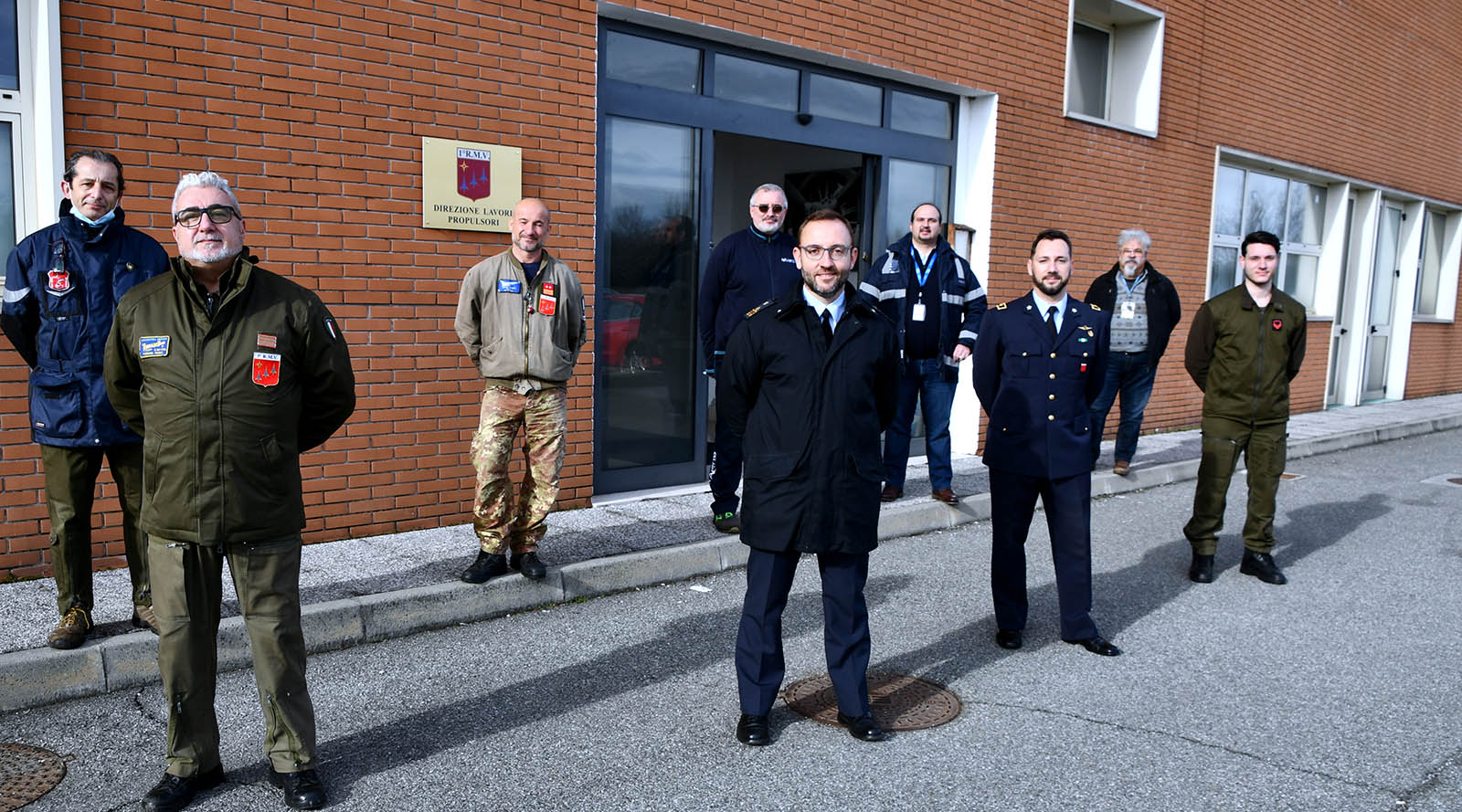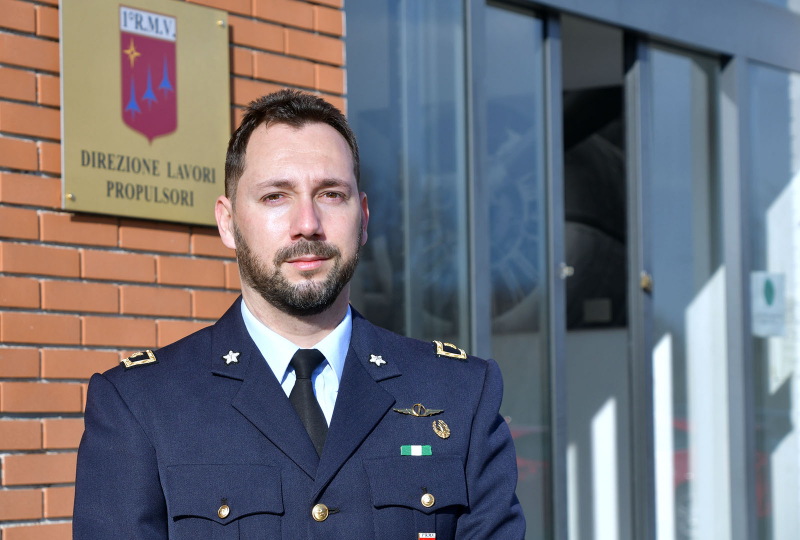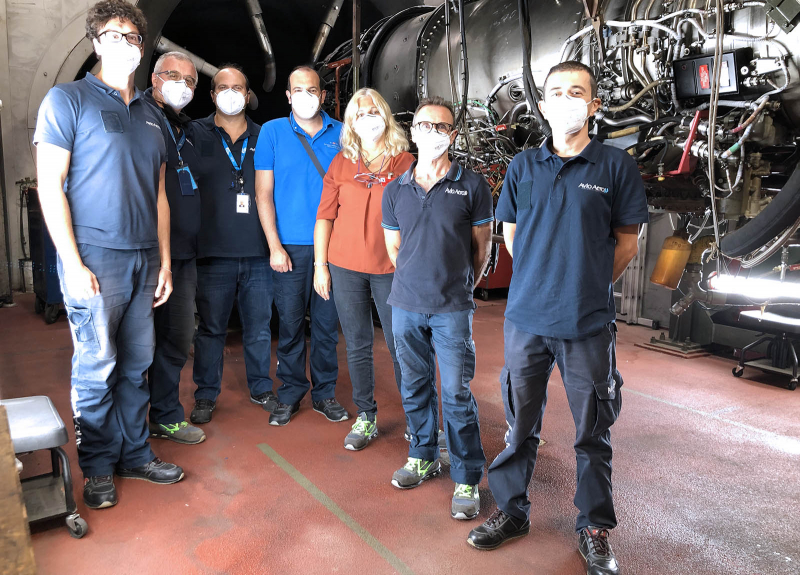Invent
Partners in Digital
The new project Italian partnered by Italian Air Force and Avio Aero enhances the digital capabilities of test rooms with new software and huge amounts of data, starting from the base in Cameri.
Feb 2021
The bright history of collaboration between Avio Aero and the Italian Air Force is expanding and consolidating with a new chapter featuring advanced digital technologies linked to the testing of supersonic engines. In Italy, there are eight Air Force bases served by teams of Avio Aero technicians and professionals and, in the case of this new joint project, the activities took place at Cameri, in the province of Novara.
A few hundred meters from the futuristic additive manufacturing plant, the Cameri base is home to the 1st Flight Maintenance Unit, the third largest in the country in terms of size, distinguished by the number of aircraft and its operational capabilities. Here, set among the gigantic hangars, office buildings and workshops, the country’s air force is in charge of logistics and the overhaul of the Tornado and Eurofighter Typhoon fleets. It is also home to the only European site for the assembly of Lockheed Martin's futuristic F-35 Lightning II stealth aircraft.
The digital renewal and enhancement project dedicated to the test room for the RB199 engine that powers the Tornado started in 2018. "We brought together about 20 other colleagues and worked intensively for two years, interacting with technicians and test room managers from the Air Force Propulsion Works Management Division in Cameri," says Donato Grossi, Software Engineering Leader at Avio Aero. "The digital enhancement was focused on two main areas, software and hardware platform: we designed and built an integrated system that makes it possible to support all activities related to testing the entire engine that allow its return to operation (known as pass-off) following overhaul and ordinary maintenance operations."
More specifically, pass-off tests are essential to ensuring the performance, efficiency of the aircraft and flight safety, as explained by Captain Giuseppe Lamberti, Deputy Director of Propulsion Works. "The tests must also meet the standards to operate in training, operational and surveillance scenarios within national airspace. Only after the necessary tests and functional checks on all systems have been carried out can the engine be installed on the aircraft."
Captain Lamberti has solid, first-hand experience, working side by side with the industrial partner. "The multi-year collaboration between the Air Force and Avio Aero is based on objectives that have been shared for years, as well as the on-going exchange of information, experiences and lessons learned, in addition to the desire to come together and work as a team in all respects."
The confirmation of this sense of togetherness comes right from the team based on field and - as happens at other bases where Avio Aero is present with its specialists - supports the air force both in person and on site, according to its technical expertise and engine skills. "For our Program Management team - deployed at the base for years to provide support in various contexts (technical area, logistics area, maintenance area, test rooms) and to contribute directly to the maintenance and in-service engine support activities, identifying the needs of the customer in a timely manner - in certain respects, it has been a new experience" said Davide Murari, National Support Organization (NSO) Project Manager di Avio Aero.
The multi-year collaboration between the Air Force and Avio Aero is based on objectives that have been shared for years, as well as the on-going exchange of information, experiences and lessons learned, in addition to the desire to come together and work as a team in all respects
The Avio Aero team based at the 1st RMV in Cameri is perhaps the largest of the teams present at the various air bases. "For the first time in fact," continued Murari, "various company functions have been involved in numerous ways to work on an important customer asset which, in this case, is not the engine but rather the systems that enable it to be used in flight. It was therefore possible to count on the strong contribution and professionalism of our people from Rivalta Engineering in Turin and Brindisi, the Facilities in Brindisi, as well as Technical Publications and Customer Support, who have collaborated and worked together actively and with determination, even in the face of the various complexities, typical of projects of this kind.
A new mission, therefore, addressed with a long-lasting synergy to equip the RB199 test cells in Cameri – and shortly, those at the base of the 6th Wing of Ghedi (Brescia) – with a new Integrated Engine Data Acquisition & Analysis System (IEDAAS) designed by Avio Aero. "This system represents the technological evolution of those currently in our military test cells in Brindisi," added Donato Grossi, speaking about the digital product from the engineering side.
"Our IEDAAS makes it possible to acquire, engineer and control all physical parameters related to engine testing; to manage the test in semi-automatic mode (the software implements the manual for engine testing and guides the operator through each step, reducing human error to practically zero); to calculate engine performance in a way that is fully integrated with systems (pre-existing or shared with the Italian Air Force); and to manage all test data and reports digitally."
Avio Aero has set up a modular, configurable and expandable platform at Cameri, so that the system (properly configured) can be used for any engine. For this reason, the same work is about to begin at Ghedi and is likely to be extended to another exceptional power unit, on which the company (as in the case of the RB199 itself, being part of the consortium of companies that owns it) is responsible for the design and production of a series of components. It involves theEJ200 for the Eurofighter Typhoon.
Our IEDAAS makes it possible to acquire, engineer and control all physical parameters related to engine testing; to manage the test in semi-automatic mode, to calculate engine performance in a way that is fully integrated with systems and to manage all test data and reports digitally
"Although we have had successful collaboration with Avio Aero in the past, in areas not exclusively related to the propeller or the aircraft - for example, for the various equipment developed for maintenance use, or for a test bench for the EJ200 - this was also a new experience for our personnel," added Captain Lamberti. "A more complex challenge than the previous ones, because it involved several sensitive and important aspects. Once again, the right feeling has been created between our teams and, with the digitization of our systems, we now have the possibility to optimize the testing on these engines, ensuring greater flexibility both for our bases and for the tests that take place in the Brindisi plant".
The specialists of the Italian Air Force are therefore looking at future outlooks with great interest, considering the experience acquired in this digital environment as a starting point for possible future cooperation on similar installations. This is also evident to those at the Cameri base who are at the forefront of testing activities, such as the Engine Section Test Bench Officer.
The digitization of our systems is certainly a way to always be at the forefront, but it also allows the automation of some processes in order to balance a sustainable use of resources which, otherwise, would be unsustainable
In fact, First Marshal Paolo Fornaro, has emphasized how crucial it is to have a holistic view of the scenario across the different levels, together with a situational awareness which is continuously and swiftly updated, along with zero delay in communication flows and decision-making processes.
"In the context of aviation, and even more so in military aviation, technology evolves in a much more complex, significant and dynamic way, “said Fornaro, "Complex, because there are different aspects to be taken into consideration (each with its own peculiarities); significant, because in the context of military aviation, technological innovations are often introduced which, in a matter of years, also reach the civil market (for example, the aircraft identification system, the digital control of engines... a classic parallelism with what happens with Formula One single-seaters and the regular cars in our streets); and dynamic, because the digital characteristics of the instruments used by the Air Force must continually adapt to the variables of possible threats, which are continuously evolving."









